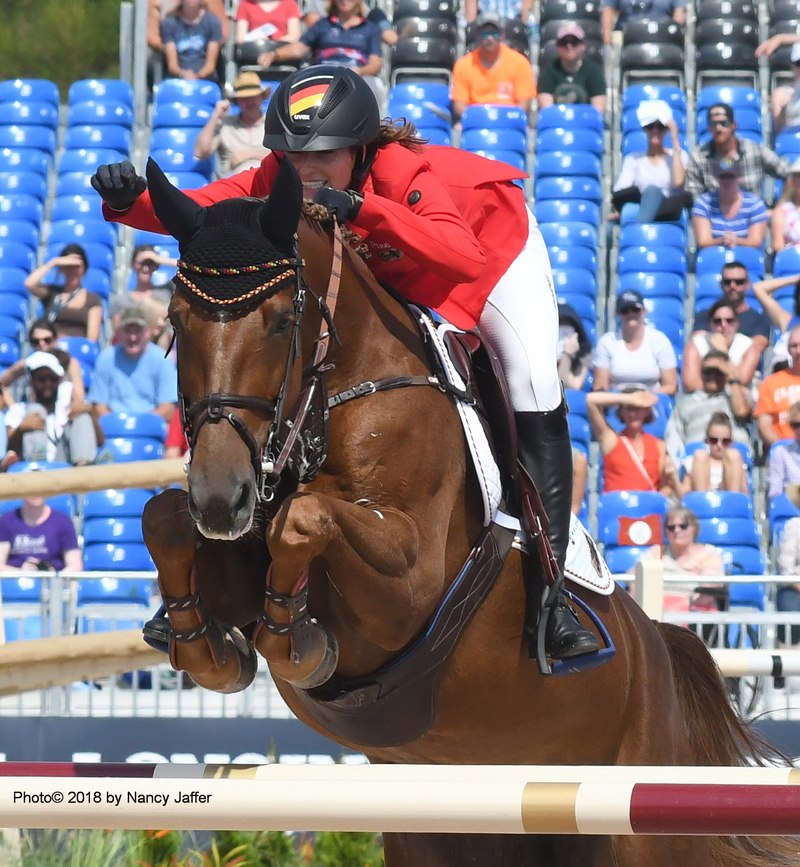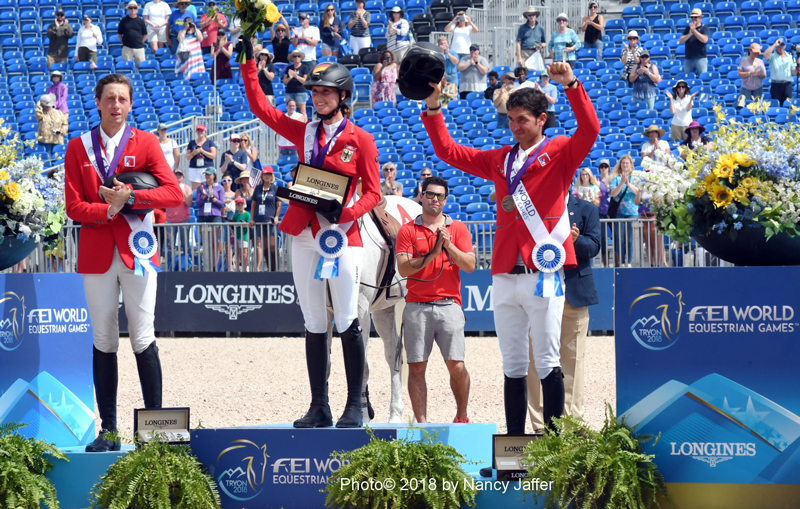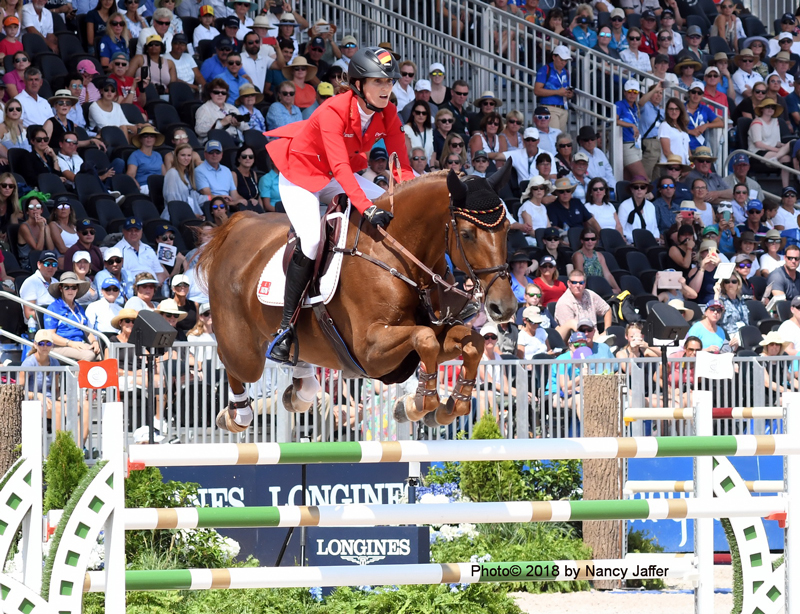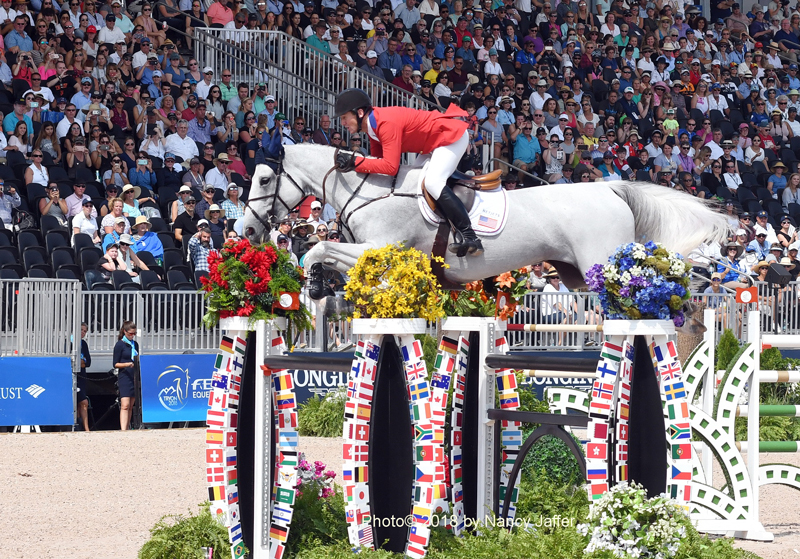The first time I ever saw Simone Blum of Germany, she was raising her arm in triumph following a clean round with the impeccable DSP Alice on the second day of show jumping at the FEI World Equestrian Games. I took a photo, impressed by both her performance and her confidence, but I have to admit she wasn’t on my medals radar. And I’ll bet most of you had never heard of her either.
Although she stood fourth when that class at the Tryon International Equestrian Center finished, I still wasn’t figuring her for a spot on the individual podium, though she was part of the German bronze medal team, headed by world number three Marcus Ehning. After all, 29-year-old Simone is ranked number 142 in the world, and a lot of those ahead of her in the standings demanded much more attention for my predictions.

But this afternoon, on the last day of the Games, she stole the spotlight. Only a single time fault, added in the final round of the top 12 this afternoon, was on an otherwise clean slate for Simone and her German sporthorse mare during the Games. The individual gold medal was hers as she shared the podium with silver medalist Martin Fuchs of Switzerland, number 17 in the world, and the Swiss 2012 Olympic gold medalist and two-time Longines FEI World Cup winner Steve Guerdat, world number nine, who took bronze on Bianca. Two out of three horses in the medals were mares, while Martin’s Clooney was the only gelding representation.

The announcer kept talking about “Alice in Wonderland,” when she entered the arena as the leader for the second round of the two-part competition, but I would translate that to Simone in Wonderland. Mobbed by the media, she kept her poise, though you could see the fuss was quite a lot for her to take in. I did a little video interview with her, but so many people were pressing that I think she didn’t really have the time to deeply consider her answers.
Anyway, click on this video and you can hear what she had to say and perhaps just get a sense of what she’s like.
Alice, now 11, was discovered four years ago by Hans Gunter Goskowitz, another German rider and Simone’s fiancée. He is, she said during her press conference, “the most wonderful man in the world. It’s just because of him I am sitting here,” she continued, then smiled and revealed, “I will marry him in the next four weeks. He will become Mr. Blum.”
Simone is the first woman to win the world championship show jumping crown since the WEG began in 1990, although Canada’s Gail Greenough—another dark horse—took the title in 1986 at Aachen, when it was still a stand-alone world championship.
But Simone noted, “for me it doesn’t matter if it’s a woman or a man. Today is a perfect day. Alice jumped the whole week really great. She is so careful, always fighting. She has the biggest heart.”

This was the first time the Final Four was not held to determine the individual world championship. That involved the top four riders jumping each others’ mounts over the same course. The format was changed because horses have become so valuable, and even having the world’s best riders take them around on a one-off can be a risk. Also, some deemed it the world catch-riding championship, which really isn’t the point.
But McLain Ward noted, with a small smile, that if there were still a Final Four, he would have been in the hunt. For the world number two, this WEG, like the last, was a case of “almost.” In 2014, he was fifth, just out of the Final Four, and today, he was fourth; again, just off the podium.

I caught up with him shortly before the medal ceremony, and I’m sure he was wishing he was taking part in it. But gracious as always even though others were demanding his time, he gave me a moment in which he expressed his thoughts.
Click on this video to hear what he had to say.
On the bright side, the U.S. had all four of its team gold medal riders in the top 25, the round that started the day. Devin Ryan dropped a rail with Eddie Blue to wind up sixteenth, but Adrienne Sternlicht and Laura Kraut made the cut with McLain to get in the afternoon’s top-12 ride-off. Adrienne finished eleventh with Cristalline despite rails in both rounds and two time faults during her second trip. The 67-second time allowed was tight. Everyone in the top 12, with the exception of Swiss Steve and Rowan Willis of Australia on Blue Movie, had time faults. Zeremonie, perfect in the first round for Laura, caught two rails and logged a time fault to finish tenth overall.
Click on this link for results.
Another U.S. team earned gold as the Games ended. It was the first time America’s four-in-hand driving squad had ever finished on top. Chester Weber, Jimmy Fairclough and Misdee-Wrigley Miller wound up with 353.39 penalties to edge the Netherlands (356.79), while Belgium was third on 364.
This was a crazy two weeks, and the first one was really tough. As always, it takes a few days for an event of this nature to get into the swing of things, but that was complicated because construction around the grounds continued while the Games began.
As the days went by, the work crews—who had problems with heat and excessive rainfall in the months leading up to the Games–did an amazing job of getting everything built, but then Hurricane Florence conspired to take things off track. Endurance race problems and the eventual cancellation of that competition, as well as cancellation of the dressage freestyle due to weather, were burdens on an already difficult production.
Heat at or near 90 degrees for days wasn’t helpful either. Many people cancelled plans to come or didn’t make the attempt because national news broadcasts painted North Carolina as a total disaster after Florence. Actually, the eastern part of the state bore the brunt of the storm. TIEC, about 250 miles west of the coast, was not affected, aside from mostly flooded parking lots on the worst day of rain, Sept. 16, when competition was called off.
Spectator seating was never entirely filled, with the weather playing a role in that. Crowd estimates were downgraded from the original 500,000 estimate a while ago, but in the end, TIEC Chief Operating Officer Sharon Decker thought attendance was in the neighborhood of 200,000, though figures are not final at this point.
The WEG isn’t easy to stage, and FEI President Ingmar de Vos assured us that the organization is taking a thorough look at what its future should be. After all, Tryon got the Games on very short notice because the original bid winner, Bromont in Quebec, lacked the financial backing to pull it off.
“We did the Games because we wanted to save the WEG,” said Mark Bellissimo, the managing partner of TIEC and several other major venues, including the Palm Beach International Equestrian Center in Wellington, home of the Winter Equestrian Festival.
“Despite historic rains and very difficult circumstances, I would put up this sport against any of the other WEGs in terms of quality of the competitions,” he maintained.
“A number of people within the disciplines said, `This was as strong championship competition as I’ve seen.’ From a sport perspective, if the goal was to save the Games and produce top sport, I believe we did that,” he commented.
The competitions that were staged did indeed offer great sport in wonderful venues, from the cross-country and marathon courses to the various arenas. Riders were complimentary about the conditions under which they competed, and they all voiced approval for the stabling.
Volunteers, of which there were 1,700, without exception in my experience all were warm, welcoming and couldn’t do enough for you. They had real pride in the fact that their region was putting on something that drew people from all over the world.
Sarah Younginer, a resident of nearby Greenville, S.C., sparkled when she talked about the WEG experience in her charming southern accent.
TIEC “had a lot of construction to get done,” she pointed out, but noted it did get finished.
“The riders being able to have their events, that was the first thing that they made sure of.” And she felt spectators and volunteers both were taken care of.
“Overall,” she declared, “it’s been an awesome two weeks.”










